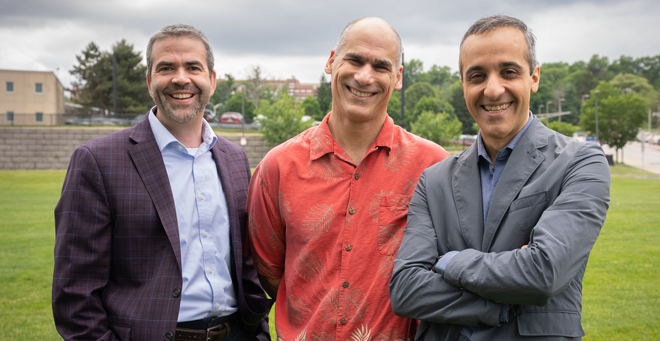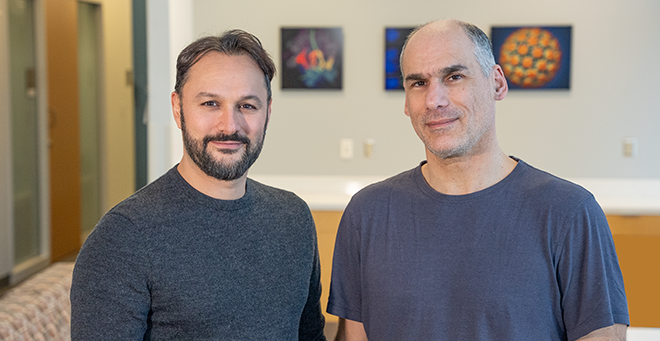
John E. Harris, MD, PhD, Manuel Garber, PhD, and Mehdi Rashighi, MD, will lead a $3.75 million clinical study at UMass Chan Medical School funded by the National Institute of Allergy and Infectious Diseases to identify preclinical genetic, molecular and biological signatures among an at-risk population that may predispose them to developing vitiligo. Enrollment for the clinical study will begin on June 25 on World Vitiligo Day.
Vitiligo is an autoimmune disease that develops when T cells attack and destroy pigment-producing skin cells called melanocytes. When a patient no longer has enough working melanocytes to produce melanin, the pigment that gives skin its color, white patches begin to appear on various areas of the body such as the hands, feet, arms, face and torso, according to Dr. Harris, chair and professor of dermatology, director of the Vitiligo Clinic & Research Center, and one of the nation’s foremost authorities on the treatment and study of vitiligo. While there are short-term treatments for the condition, there is no cure and depigmentation returns in 40 percent of cases within the first year after treatment.
There is a strong genetic component associated with vitiligo but unraveling the complex array of approximately 200 genes, as well as environmental and other factors that may contribute to the disease, is an ongoing challenge for researchers as there is a paucity of genetic and biological samples from a representative group available for study.
“Vitiligo is influenced by our genes, but further understanding the interplay of genetics, environmental and other biological factors such as RNA, and protein biomarkers is critical to identifying disease preclinically,” said Harris “If we can isolate subclinical signatures of disease, we can potentially predict which patients are at the greatest risk of developing vitiligo and develop new treatments for the disease.”
Harris and Dr. Rashighi, assistant professor of dermatology will enroll and collect biological samples and questionnaires from approximately 1,000 participants over the next five years. Of the 1,000 enrollees, 200 will be patients diagnosed with vitiligo. The remaining 800 will be family members at risk of developing the disease. It’s expected that 40 to 60 of those people will be newly diagnosed with vitiligo during the course of the study.
A unique feature of the clinical study is that it will be conducted entirely remotely. Every six months, enrolled participants will be mailed questionnaires and sample collection kits for saliva, blood and skin tissue that they will return to the investigators through the mail. Saliva will be genetically sequenced for each participant. Additionally, DermTech tape strips and custom microneedles, developed by collaborator Darrell Irvine, PhD, at MIT, will be used to collect skin samples and analyzed for biomarkers and RNA associated with disease onset and severity. Finally, an at-home blood and serum collection platform developed by device manufacturer Tasso uses negative pressure to draw blood noninvasively from capillaries without the need for syringes or venipunctures. Blood samples will be genotyped and analyzed for antibodies and other biomarkers. Participants will also be responsible for filling out a questionnaire regarding diet, health and lifestyle to identify environmental or outside factors that might contribute to disease onset or severity.
Once all this data is collected and tests are run on the samples, the task of analyzing and making sense of it falls to Dr. Garber, professor of molecular medicine, a member of the Program in Bioinformatics and Integrative Biology, and director of the Bioinformatics Core at UMass Chan, and his team.
“All this sampling generates an enormous amount of data,” said Garber. “It’s not just 1,000 genomes, but 1,000 genomes and hundreds of RNA profiles, antibody tests, questionnaire answers and other information that needs to be accounted for. There are millions of data points to make sense of and to comb through and look for associations. We will be developing new data models that will analyze all this information, and searching for subclinical signatures of disease.”
At the end of the study, Harris, Garber and Dr. Rashighi, assistant professor of dermatology, hope to have identified and characterized changes or events that correspond with disease progression or severity. Using this information, clinical scientists can build models to predict disease onset, progression and relapse. Information gleaned from the clinical study can also be used to inform the course of other autoimmune diseases in which the body’s immune system attacks its own cells.

